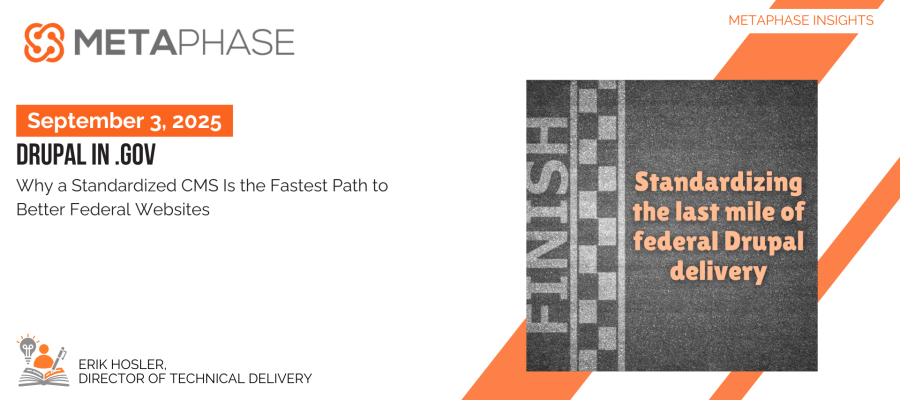
Federal agencies are under a mandate to deliver simple, secure, mobile-first digital experiences. OMB’s M-23-22 makes it explicit: websites are now the primary way the public interacts with government, and agencies must design for a “digital-first public experience” that is accessible, consistent, and secure. The memo directs the use of the U.S. Web Design System (USWDS) and alignment with Federal website standards—clear signals that standardization is no longer optional.
Here’s the scale and opportunity. Government’s web ecosystem is vast, but traffic is concentrated. OMB and GSA report that among sites using the Digital Analytics Program (DAP), the 50 most-visited .govs account for nearly 80% of all pageviews. Yet, as of November 2024, only 29% of scanned sites fully meet accessibility metrics, 25% meet design consistency, and 41% meet mobile-friendliness. A standardized CMS approach, anchored in USWDS and shared components, targets exactly these gaps at enterprise scale.
Why Drupal
USWDS-native and standards-ready. Drupal has mature USWDS themes and starter kits that bring federal design tokens, components, and patterns directly into the CMS layer—accelerating compliance and cutting unnecessary rework on front-end design. The official Drupal USWDS project and ecosystem are actively maintained for current core versions. Pair that with GSA’s Federal website standards (which incorporate USWDS), and agencies can roll out consistent, policy-aligned UIs far faster.
Security you can plan for. The Drupal Security Team operates a transparent advisory and release process with predictable security windows (core security release window: typically the third Wednesday each month). That cadence lets federal teams design change windows around known release patterns, close vulnerabilities quickly, and document mitigations for ATO packages.
Headless and interoperable out of the box. JSON:API ships in core, providing zero-config RESTful CRUD endpoints for all content entities. That makes Drupal a clean content hub for decoupled front ends, data visualization tools, and microservices—while preserving governance, workflow, and Section 508 controls in one place.
Governance and publishing efficiency. Core Content Moderation and Workflows let you define draft–review–publish states, route approvals by role, and keep auditable revisions—without custom code. These capabilities reduce cycle time while strengthening change control, which agencies need to align with M-23-22’s calls for evidence-based governance and continuous improvement.
Designed for federal shared services. Drupal integrates easily with Search.gov via maintained modules and with DAP via a dedicated module—so agencies can meet analytics and search expectations while leveraging government-wide services instead of bespoke solutions.
Run it where compliance lives. FedRAMP-authorized cloud services commonly used to host Drupal are openly listed on the FedRAMP Marketplace, enabling consistent security baselines, continuous monitoring, and faster ATO sustainment.
Modernize on time. With Drupal 7 now past its official end of life, agencies face a natural upgrade moment to move to current Drupal with USWDS, consolidate legacy microsites, and eliminate duplicated modules and custom themes.
The Standardization Dividend (with Metrics)
A single, standardized Drupal platform delivers measurable gains aligned to M-23-22:
- Accessibility: USWDS components and documented patterns reduce defects that automated scanners catch, while centralized theming and moderation make manual 508 review easier to operationalize. Today only 29% of scanned sites fully meet accessibility metrics; using a shared design system through Drupal themes is a direct lever to improve that percentage across an enterprise portfolio.
- Design consistency and mobile: Only 25% of sites fully meet design-consistency metrics and 41% meet mobile-friendliness. A standardized USWDS-based Drupal theme and component library eliminates per-site CSS drift, pushes responsive patterns by default, and raises baselines across dozens of sites at once.
- Analytics and insight: DAP integration in Drupal yields consistent analytics data for portfolio-level decisions. With OMB highlighting performance accountability and TechStat-style reviews, having uniform metrics across sites is the difference between anecdote and action.
- Security posture: Predictable Drupal security windows and a public advisory process simplify patch playbooks and change control, helping agencies demonstrate Zero Trust progress cited in M-23-22 while meeting CISA expectations for continuous hardening.
- Operational scale: Because the top 50 sites account for nearly 80% of pageviews, migrating that high-impact tier to a single Drupal platform can concentrate CX improvements where they help the most, then cascade patterns to the long tail.
How MetaPhase Makes Drupal Work Harder for Government
MetaPhase standardizes the “last mile” of federal Drupal delivery—governance, security, data, and UX—so you don’t have to reinvent it program by program.
- Composable data visuals for content teams. Our DrupalDataDotDev tool (https://drupaldata.dev) generates accessible, USWDS-styled visual components and embeds them directly in Drupal content—no custom front-end sprint required. Editors can drop charts, stats, and dashboards into pages in minutes. Connect them to JSON:API when datasets need to refresh using included Drupal Controller and Block Plugins.
- Start-Left Security and Continuous ATO. We bake security into Drupal from day one, and automate the evidence so updates ship without duplicating ATO paperwork. That’s the heart of our Start-Left and continuous ATO approach applied to CMS—design decisions, modules, and pipelines mapped to controls up front, then continuously verified.
- Governance that sticks. Drupal’s workflows and roles are only as good as the operating model. We implement portfolio governance patterns that connect site KPIs to mission KPIs—so content debt, accessibility debt, and mobile performance are managed like real risks, not afterthoughts.

